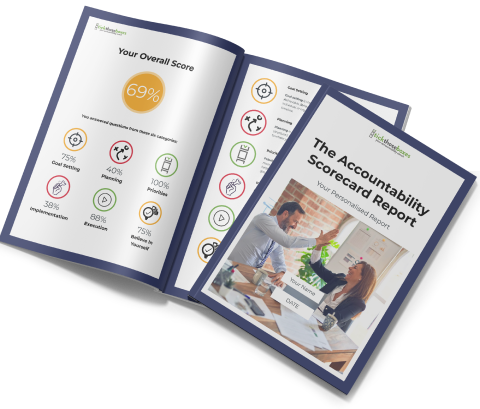No matter the size of your business, smoother operations make everything feel easier. When systems are clunky or unclear, it leads to delays, dropped tasks, and confusion around roles. That usually means frustration for teams, missed deadlines, and unhappy customers. However, when operations operate smoothly, work becomes more organised, individuals understand their responsibilities, and the outcomes demonstrate their worth.
Discover your Accountability Score and increase the probability of smashing your GOALS and Getting Sh!t Done!
Streamlining your business doesn’t require a complete overhaul. It means looking at what’s already working and finding smart ways to build on it. Minor improvements across multiple areas often have a bigger impact than one major change. Whether you’re running a growing team or managing a larger operation, knowing where to start is the first step.
Assessing Current Operations
Before rushing to change things, take a moment to really study how your current systems are running. Unidentified problems are impossible to solve, and many businesses fail to recognise the hidden unnecessary effort in their daily operations.
Start by walking through your operations from end to end. Where is the slowdown occurring? Could there be tasks that are being repeated more than necessary? Could the handovers between teams be made more seamless? These are often signals of where improvements could make a big difference.
One useful approach is to get your team involved. The people on the ground usually see inefficiencies that don’t show up in topline reports or dashboards. You’ll also find that team members are more open to improvements when they’ve had a say in identifying issues. You could start by asking:
– What stands in your way during a normal workday?
– Are there steps in your process you think could be simplified or removed?
– What tools or systems slow you down?
– Where are things constantly getting reworked or fixed?
– Which approvals or sign-offs seem to take too long?
This step might feel mundane, but it’s key. You’re figuring out what’s clogging up progress so you know exactly where to focus your energy. It also sets a clear picture of what “better” looks like. It can be advantageous to document everything you discover during this stage, not only so you can measure progress later, but also so your team sees that feedback isn’t wasted.
Implementing Process Improvements
Once the areas needing improvement are clear, begin focusing on solutions that improve work flow across your organisation. Occasionally that means a big shift in tools or systems, but often it just takes a few smarter processes to speed things up.
Start by looking for patterns. Could multiple departments be experiencing issues with the same slow system? Are people double-handling paperwork or digital tasks? Small process redesigns can often resolve these cross-team struggles. Examples might include:
– Swapping out outdated tools for a single, centralised platform
– Creating shared templates to reduce repetitive manual work
– Setting clearer rules for handovers or project stages
– Automating easy-to-repeat tasks through scheduling tools or system triggers
Standardising key procedures and creating Standard Operating Procedures (SOPs) helps, too. When each team is doing the same task in a different way, things become messy fast. Consistency cuts waste and confusion without needing extra effort. Think about codifying those regular tasks. That way, people across teams don’t have to guess or reverse-engineer each other’s steps.
Sometimes, the changes you need aren’t about tools or workflows, but expectations. Have clear, basic standards around quality, timelines, and responsibilities. That way, the effective processes you’ve established actually deliver the return you’re aiming for. One business we worked with saw a big improvement in project delivery timelines just by tracking approval points more closely and nudging delays early. No fancy software required, just clarity and consistency.
The goal is to reduce steps, remove confusion, and provide people a simpler pathway to achieve their work done well. It’s often those behind-the-scenes tweaks that lead to smoother days and stronger results.
Training And Development To Improve Performance
Even with robust SOPs in place, teams require appropriate training to maximise their effectiveness. If people don’t feel confident using new tools or following updated workflows, mistakes pile up and momentum stalls. Training isn’t something you tick off once and forget. Training is a continuous component that significantly influences the efficiency of operations.
Start by checking in on current skill levels. In which areas might staff members be encountering challenges? Are there tasks that often need rework? Gaps in knowledge are usually easy to spot when you’re paying attention to common errors or areas that slow things down. Please consider setting aside time to provide focused training in these areas, rather than implementing a one-size-fits-all program.
Give people a chance to learn in real time. Micro-training sessions during the week often work better than long, one-off workshops. They’re easier to fit into the schedule and more relevant when placed close to the task itself. A quick 15-minute refresher or walkthrough at the start of a shift can make someone far more effective right away.
Leaders also play a big part here. When leadership models a mindset of learning and openness, others tend to follow. If staff feel supported instead of judged, they’re more likely to speak up when they need help or when something doesn’t make sense.
Training shouldn’t be something that’s only reactive. Plan ahead. If you’re about to roll out a new platform or system, invest in early upskilling. By giving staff the time and space to comprehend the changes before expecting them to adopt them, you can prevent future resistance.
Keep Operational Standards On Track With Feedback Loops
Once changes are in effect, it’s easy to move on and forget about them. Don’t. Create regular habits around checking how things are going. That way you can spot when a fix stops working or when another issue starts to form.
There’s no need to make this step more complicated than necessary Keep it tight and manageable. Run short team check-ins every few weeks. Use a simple set of questions to see what’s improving and what still needs tweaking. Try something like:
– What’s been easier over the last month?
– What’s still clunky or confusing?
– Where are wait times slowing us down?
– Are any tools causing more work than they’re saving?
Once you gather this feedback, please take action on it. Even small changes in response to team input build trust and make people more open to future improvements. When staff see their ideas being listened to and applied, they tend to feel more invested in the success of the system as a whole.
It helps to track a few key metrics alongside these conversations. Look at things like task completion rates, turnaround times, or customer feedback. These give a clearer view of the outcome of your operations, rather than just the behaviour inside them. It also gives you something to base future decisions on, instead of relying entirely on gut feel.
Feedback loops aren’t only for fixing problems. They’re just as valuable when things are working. They help you lock in wins, repeat successful practices across teams, and recognise the people who make it all happen.
The Role Of Coaching For Business Owners Who Want Smoother Operations
Sometimes it’s difficult to view operational issues clearly when you’re inside them every day. Business owners who want to speed things up and clean up inefficiencies often benefit from having someone hold the bigger picture.
A coach can help identify hidden barriers that you may have grown used to. They remain detached from the traditional methods. That distance helps them ask the right questions and guide you towards real, workable solutions. The support goes further than just identifying the blockages; it helps you put plans into motion and stick to them.
An accountability coach focuses on follow-through. It’s not just talk. You commit to a strategy, and you get a partner who makes sure it actually gets done. That’s especially useful when trying to push big internal changes, streamline multi-step processes, or gain alignment across leadership teams.
For example, one business owner struggled with team members missing important handover details between departments. A coach assisted in mapping out the gaps, adding new checkpoints, and providing staff with consistent support to meet these expectations. Things didn’t correct themselves overnight, but within a few weeks, both communication and delivery had already improved.
Whether it’s about improving coordination, cutting down delays, or freeing up leadership time to focus on growth, coaching has a way of shifting momentum. It’s not just about tools or systems, either – it’s about building the habits and mindset needed to improve processes long after that initial push.
Maintaining Streamlined Operations Over The Long Term
Once your operations are running better, the job’s not done. Staying consistent takes work. Over time, teams grow, tools change, and expectations evolve. That’s why it makes sense to build in regular time to verify if your processes still match how the business actually runs.
Block out time each quarter or at set project intervals to audit your systems. What worked three months ago might not be right anymore because the pace of work has changed or new services have been introduced. Waiting too long to update processes causes the old problems to creep back in.
Keep improvements simple and easy to understand. If a process becomes too fancy or packed with exceptions, people tend to ignore it. Clear pathways beat clever workarounds every time. This kind of simplicity also makes training new staff easier and reduces the time needed to get them up to speed.
Don’t aim for a perfect system straight away. Focus on small changes you can stack. Prioritise changes that reduce errors, free up time, and make it easier for your team to focus on quality.
Coaching support is one way to keep this consistency. An external voice can bring fresh perspective, catch blind spots early, and help you build accountability around making and maintaining change. That way, operational improvements don’t just fade into the background – they fuel stronger results well into the future.
Whether you’re looking to fine-tune operations or boost efficiency, coaching for business owners can be a game-changer. With expert guidance, you can streamline processes and maintain momentum towards your goals. Let us help you sharpen your focus and achieve the results you’ve envisioned. “Tick Those Boxes” specialises in helping individuals and organisations become more accountable. Contact us to learn how our programs can help you create a more effective and accountable workplace, where you and your teams do what you say you will.


